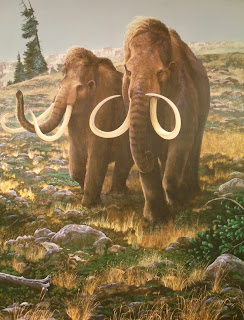Dear
George,
I’m
just back from a camping outing at Big Bone Lick State Park in Boone County,
Kentucky. What an amazing place! Big Bone Lick is known as the
birthplace of American paleontology. During the last great Ice Age, over
10,000 years ago. a myriad of now-extinct herbivorous mammals frequented the
Lick: wooly mammoths, mastodons, the stag-moose, giant sloths, ancient bison,
primitive horses. The Lick’s salt springs and salty earth drew the
animals which used it to supplement their diet. Because of the swampy
marsh land, many of the animals became mired down in the bogs and died there,
their fossil remains preserved over the millennia.
Native
Americans inhabited the region as far back as 13,000 years ago and used the
Lick for hunting big game and gathering salt. The first European to visit
the Lick was a French Canadian, Charles LeMoyne, who came in 1739.
Meriwether Lewis traveled down the Ohio River to Big Bone in 1803 on his way to
join William Clark for their westward journey, and Lewis sent a box of
fossilized big bones back to President Thomas Jefferson. Jefferson
devoted considerable study to Big Bone Lick and believed that some of the
mammoth animals might still be living in the American West. At
Jefferson’s request, Clark later returned with a party of ten men and shipped
three huge boxes of bones to Jefferson, who kept one batch at the White House
and sent the remainder to the American Philosophical Society in Philadelphia
and to the National Institute of France in Paris. A salt industry
developed in the area in the late 1700’s, and Big Bone Lick, with its purported
medicinal springs, became one of the most popular resorts in the Ohio Valley in
the first half of the nineteenth century.
The
state park was established in 1960 and, along with a 62-site campground,
includes a small museum which recounts the region’s history from 450 million
years ago to the present and displays fossils and a 1,000 pound mastodon skull.
The 4.5 mile Discovery Trail includes stops at a salt springs and a
viewing area for the bisons who live in the park. I spent some time watching a herd of twelve glorious bisons
on my visit, including four youngsters. Here are a few photos.
Love,
Dave
SOURCES:
www.nps.gov, “Lewis and Clark Expedition: Big Bone Lick
State Park”: www.parks.ky.gov, “Big Bone Lick
History”
The Museum Center
Mastodon Skull
Wooly Mammoth Molar
Woodland Muskox
Mastodon Tibia and teeth
Mastodon Tooth
Stag-Moose
Adena Flint Spear-Points
Mastodons at the Lick
On the Discovery Trail
The Lake
Ancient Bison
A Salt Spring
The Bison Herd




































































































































































































No comments:
Post a Comment